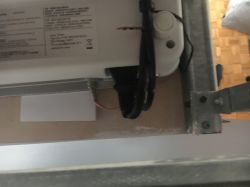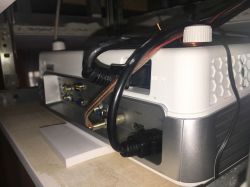
Hello!
During the renovation of the living room, I came up with the idea to hide the projector and screen for the projector in the suspended ceiling (or more precisely in the decorative band under the LED lighting). One button activating the projector was supposed to turn a seemingly ordinary living room into a cinema room ...
The design is based on 15cm drawer guides with full extension. The guides must be mounted parallel to each other in all planes. The structure of profiles for GK frames does not facilitate their calibration. I think it would be easier with a wooden structure.
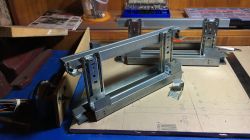
The motor rotates a threaded rod on which two lines are wound on the left and right side. I secured the place where the lines are wound with reinforced tape. The cables run through pulleys and are then attached to the moving part of the lift with cable ties. You can easily adjust the left-right tilt with the bands. In addition, they are the weakest elements, so if the lines are pulled in further than expected, the bands will break without damaging the structure.

The manual control of the elevator is carried out on the car window switch directly on the engine circuit. Thanks to this, in the event of problems with automation, it is possible to raise or lower the lift manually. The upper limit switch in position (NC) closes the motor circuit when the elevator has not reached the upper position. Otherwise, the circuit is open and the motor cannot run in that direction. The limit switch is moved by a piece of profiled plywood with which you can adjust the upper position of the lift. The lower position of the lift is always the same - all guides are fully extended and slack. As a result, the projector is always in the same position when it is turned on.

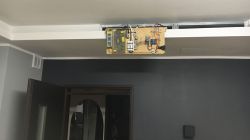
Automatic control is carried out on two relays controlled from the microcontroller. When the projector is started, voltage is applied to the 12V trigger output. After breaking with resistors to ~ 5V it goes to Arduino. The signal from the limit switch, when the elevator has not reached the upper position (NO), is sent to the microcontroller (short circuit to ground). When the projector's status changes, one or the other relay is activated for a specified period of time. If for some reason the Arduino starts up, when the elevator has not reached the top position and the projector is turned on, the elevator will not be lowered. Arduino also controls the projection screen.

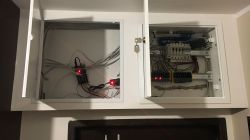
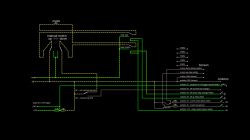
The elevator does not cause any problems so far. I also plan to add a 12V 2A fuse, which in theory should burn out when the engine is too heavily loaded. Optionally, you could add a lower limit switch somewhere on the moving element of the elevator.
Estimate:
| PLN 160.98 | drawer slides, two pairs, 15cm, full height |
| PLN 30.00 | plywood, UD30 profile, fleas, threaded rod, rope, pulleys, screws, nuts, washers (approximate amount) |
| PLN 25.65 | power supply with a power reserve of 80W 12V DC 6.67A |
| PLN 29.00 | Hyundai Getz front wiper motor (engine without additional gear causing the axis to move back and forth) |
| PLN 10.00 | universal switch for car windows |
| PLN 1.70 | limit switch |
| PLN 36.90 | arduino mega (you can use UNO for half the price) |
| PLN 9.00 | module of 2 relays 5V |
| PLN 2.90 | universal plate |
| PLN 5.00 | transistors, resistors, pins, wires (approximate amount) |
| PLN 47.53 | transportation costs |
| PLN 358.66 | sum |
Cool? Ranking DIY





